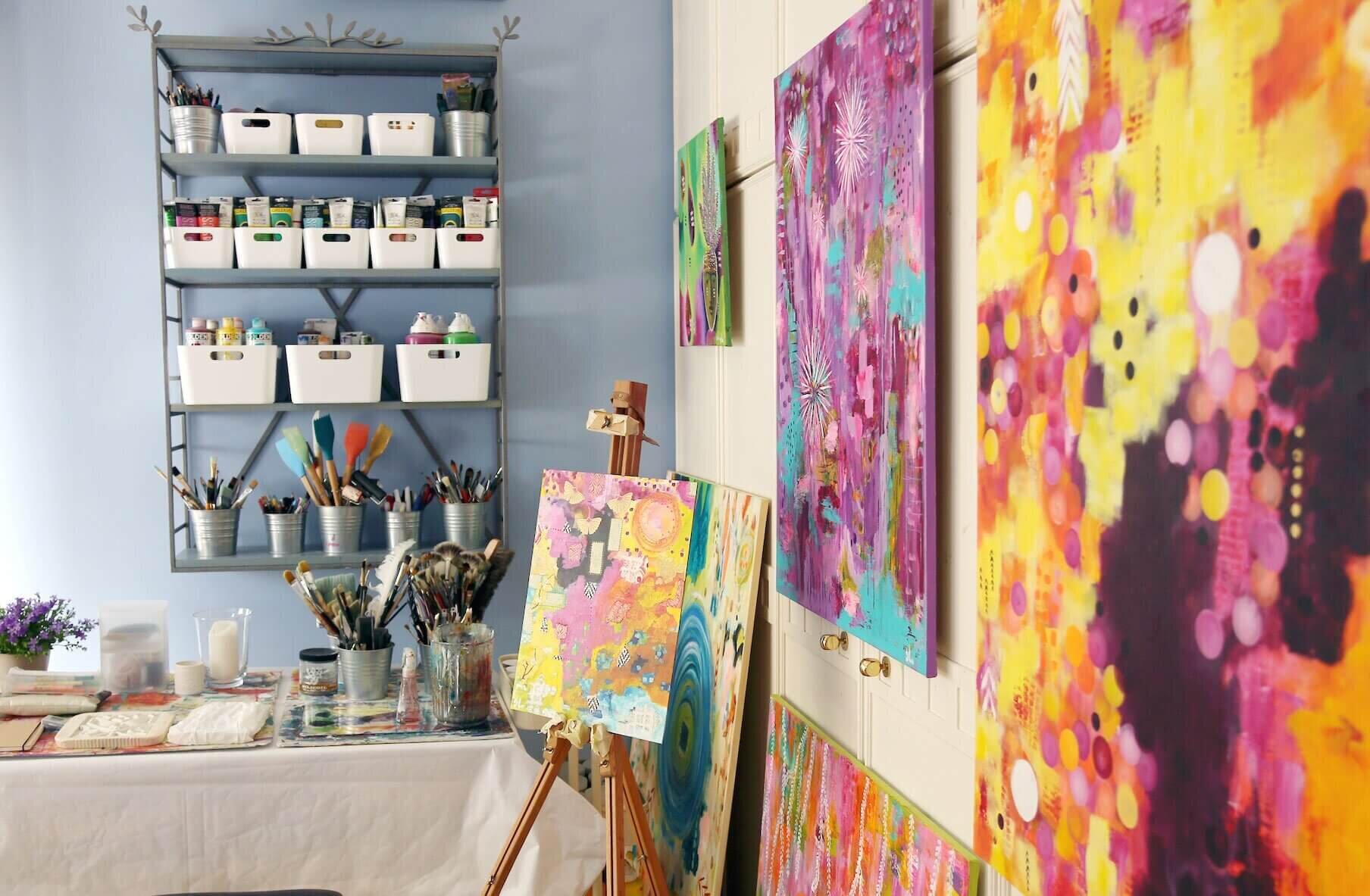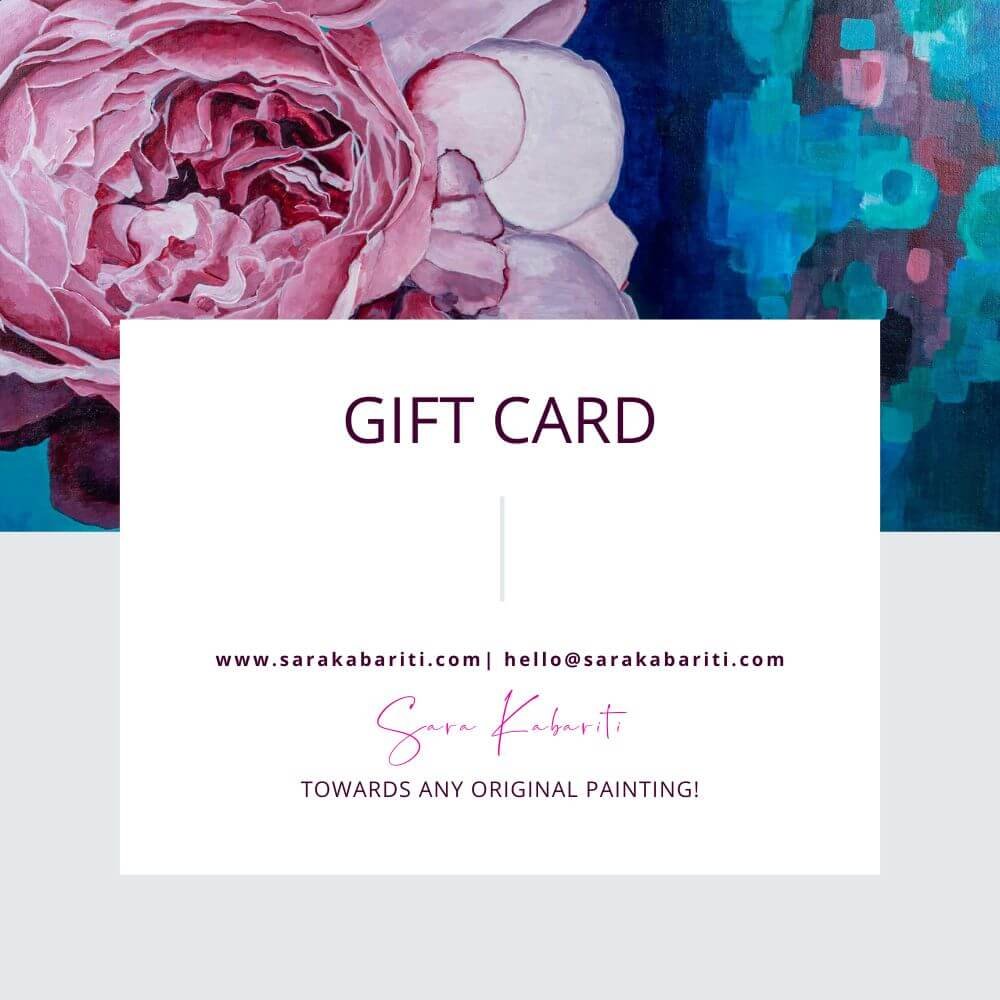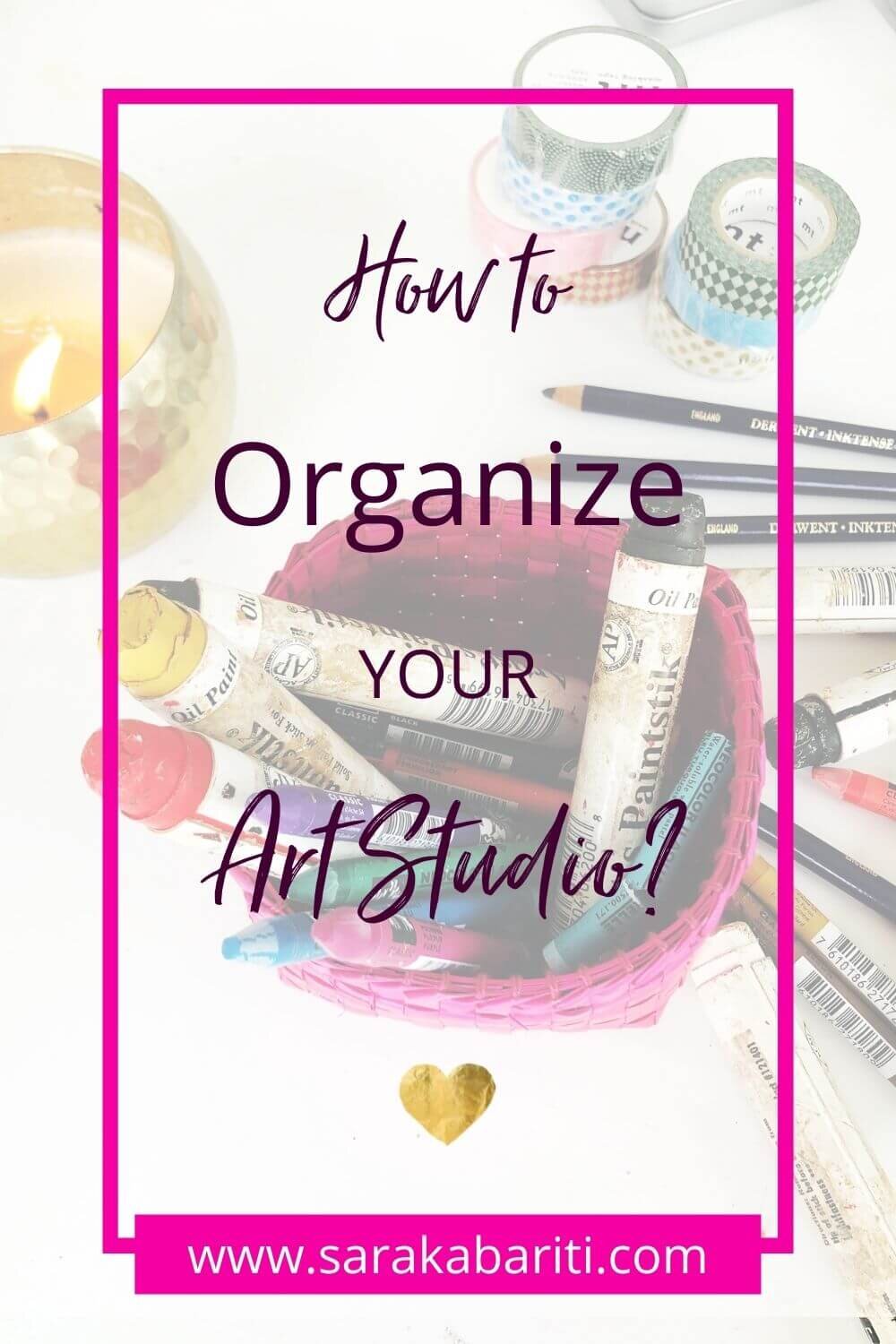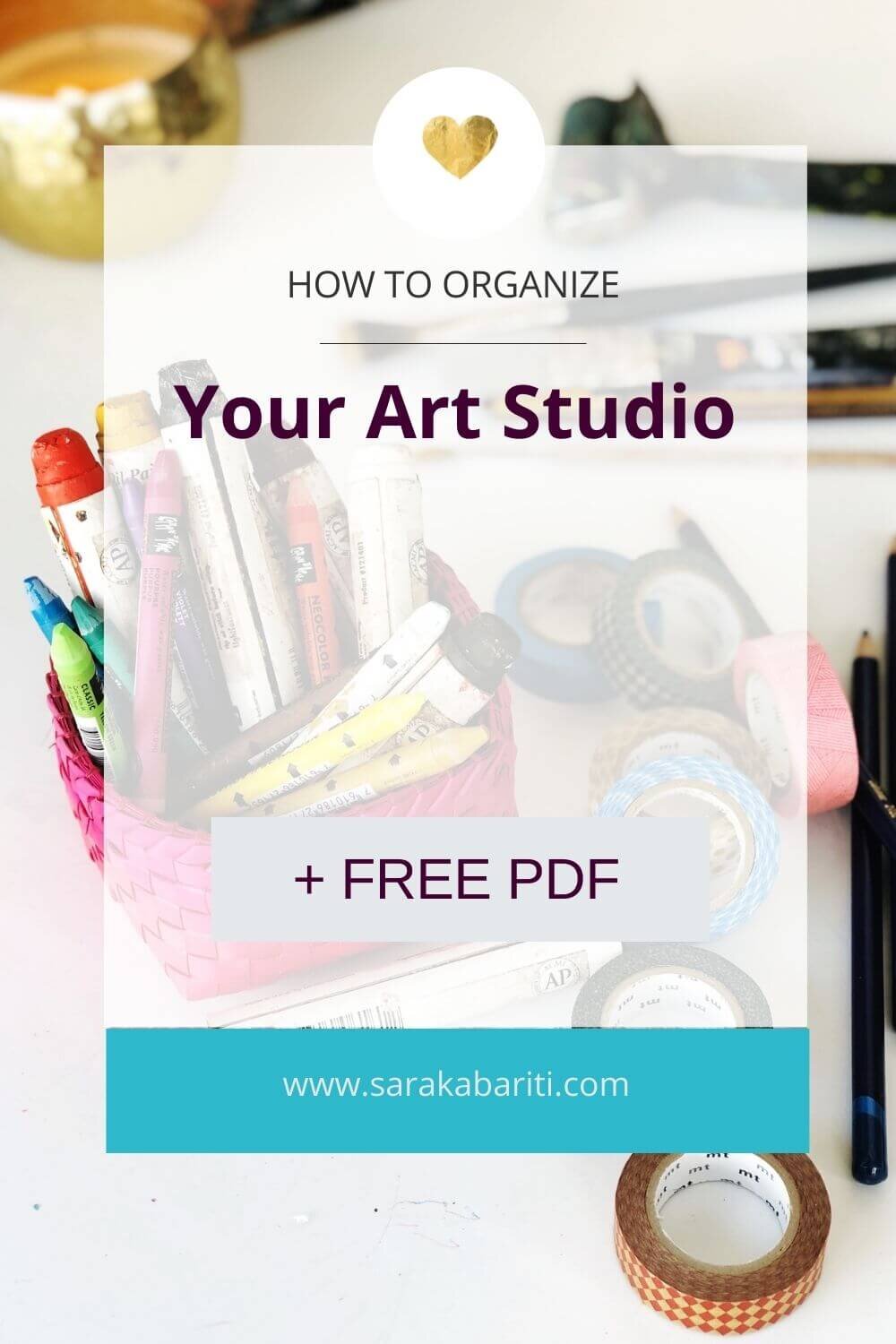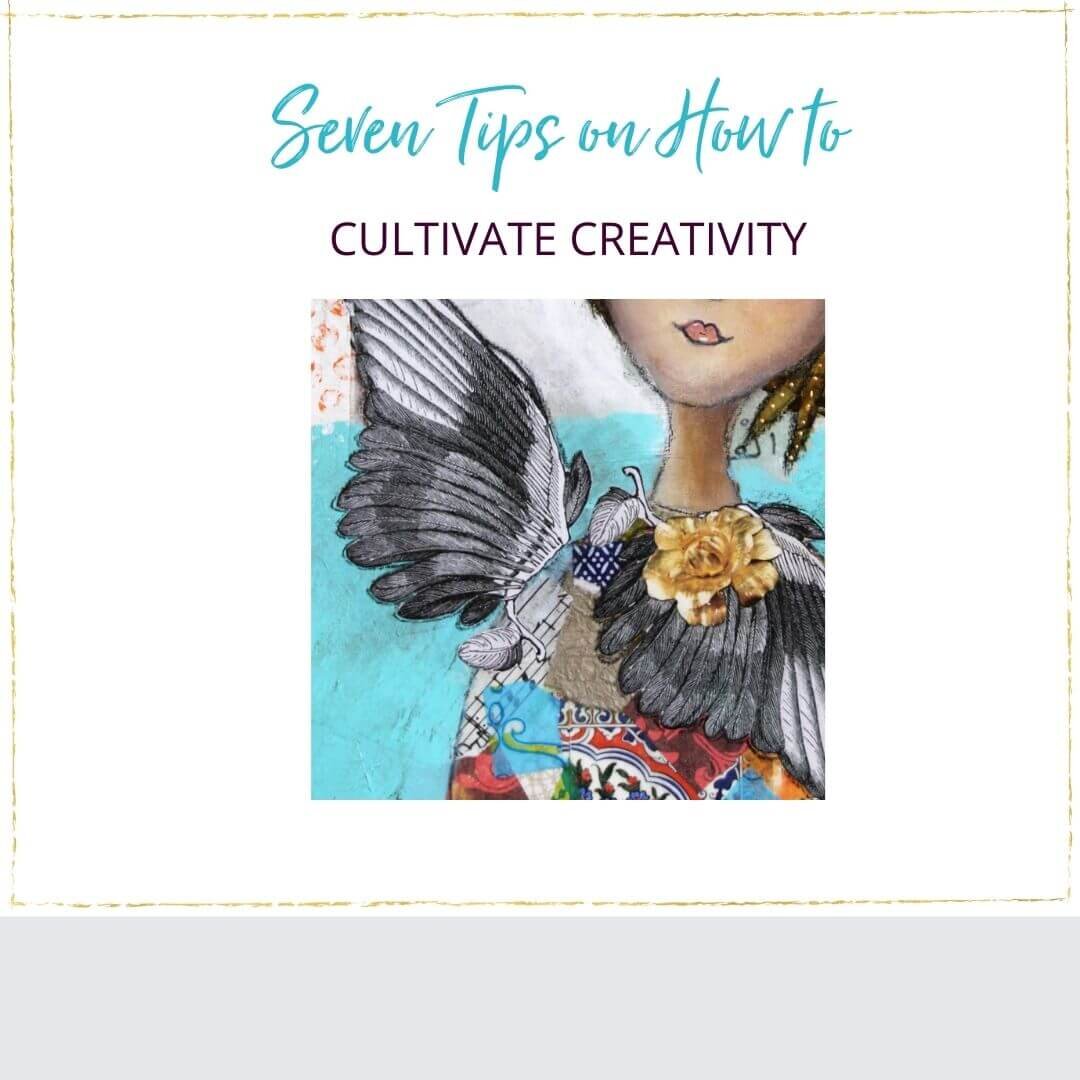How to Organize your Art Studio
Order in your creative space gives you head space.
Keeping your art studio tidy sets you up for success.
Now that our home renovation project is over, I spent most of this month clearing out my house and I have to tell you it feels great! It was a huge relief particularly once I got my home art studio in order. The thing is, I’m ready to start on a new body of work but I had a long ‘to do’ list vying for my attention. Until I attended to those tasks, I was unable to focus on much else, least of all my art.
Tidying up your external surroundings inadvertently clears up mental clutter. Discover my top 6 tips to get you started on organizing your own creative space. I'm also thrilled to introduce you to a special guest this month. Meet fine artist and surface pattern designer Beth Armstrong from New Zealand. Scroll down for the full interview!
What sparks your creativity and how do you tackle organizing your art space? I would love to hear what works for you. Feel free to drop me a line by clicking below.
Sara xo
Join our creative community and receive your FREE downloadable guide with my top 6 Studio Organization tips for creatives. Link below!
Quote of the month
"The best way to find out what we really need is to get rid of what we don't."
(Marie Kondo)
Tell us a little about yourself?
I was born in the Shetland Islands in the far north of Scotland. At the age of 9, we moved to the hebridean Isle of Rhum, a National Nature Reserve on the West coast. My father worked in Conservation for most of his life so I was encouraged to explore and learn about our natural world from an early age. One of my most vivid memories from that time was watching a white-tailed sea eagle (brought to the island as a chick and part of a conservation project to re-introduce the species to the island) take flight for the first time. A lot of our school projects were based around the natural environment of our island and the conservation projects that were taking place at that time. I remember learning how to take scientific rainfall measurements, watching field researchers conducting studies on the habits and behaviour of the Red Deer, discovering the historic importance of the geological formations of the land and of course like many children of my age back then I spent many hours on the beaches spotting seals and searching for crabs. To this day I still find peace and a sense of calm listening to the wildness of a roaring wind, the crashing of the waves and rain lashing on the roof.
Creative Arts play a strong role both within my immediate family and my wider relations, my father is a writer and poet, my mother was a knitwear designer in the 70s and my sister is now a well known knitwear designer. My grandmother was a painter, documentary film-maker and writer and she published several books on her travels to Pakistan during the 1950s. During my teens I lived in Edinburgh where I was introduced to art galleries, museums, theatre and foreign-language films. I began to develop my own aesthetic preferences and discovered how much I loved the elegant Georgian architecture of the city, the beautiful Royal Botanical gardens and discovered the work of Scottish Architect, Designer and Artist Charles Rennie MacIntosh whose watercolour paintings have had a deep influence on my own painting practice.
Although I studied Art at school, and have always appreciated the world of Art and Design, it wasn’t until much later in my life and after moving to New Zealand that I discovered the strong pull towards drawing and painting for my own pleasure. This discovery led me to pursue a diploma in Art & Creativity and later to complete several online courses with Make it in Design and Bonnie Christine on how to create surface pattern designs digitally using my original hand-painted artwork. One of my goals is to work with the interior design industry to realise my artwork on soft furnishings and fabric. I would also like to continue to explore my love of fine art and am currently working on my first floral watercolour collection. From the North Atlantic to the South Pacific, my story is the tale of two distant shores separated by eleven thousand miles but connected by a long history of sea-farers. Island life is no stranger to me.
How did your journey as a Fine Artist begin?
It really all began in Shetland in the 1970s. My parents were very influential in shaping my artistic taste, they had many books on art in our house and my mother appreciated great interior design. During that time, my mother ran a very successful knitwear design business in Shetland and as my father worked in Conservation, I was introduced to the beauty of both the natural world and design at an early age. This influence continued to shape and guide my own aesthetic preferences as I grew up but it wasn’t until much later in my life, well after I completed my Higher studies in Art at school, that I gave myself permission to fully explore creativity as a career choice. Picking up my pencils again in 2017, it felt like I had re-discovered an old friend and time seemed to disappear when I sat down to draw. Tuning in to this signal, I pursued a diploma in Art & Creativity and since then have been exploring different media but quickly discovering watercolour and falling in love with its soft delicate nature and how it lends itself so well to botanical art.
What inspires your creativity?
Nature first and foremost. I am deeply inspired by all things botanical but I also draw inspiration from beautiful interior design, fashion, arthouse cinema and architecture. I am very fortunate to live right next door to one of the most beautiful botanical gardens in New Zealand, Pukekura Park. I have spent many hours photographing, sketching and painting the lush native trees and ferns that reside here.
I notice you use a lot of botanical motifs in your patterns. What is it about them that you love?
I feel a strong connection to the natural world, shaped by my upbringing on remote Scottish Isles. I owe this deep appreciation and wonder of our magnificent flora to my father and his devotion to conservation. Drawing and painting from nature feels like the most natural thing for me to do. It is also a very peaceful and calming practise which helps me to relax and fully immerse myself in the pleasure of creating something with my own hands.
At what point did you choose to enter the world of surface pattern and why?
I first discovered the world of Surface Pattern Design in 2018 when I came across the courses offered by Make it in Design. I remember a moment of realisation that I could take my botanical motifs and love for design and marry the two. I also wanted to be able to run my own business and work from home and this industry seemed like the perfect fit.
How does working with a computer as a tool to create your designs feel compared to creating your motifs by hand?
Designing from scratch directly from the computer doesn’t feel at all natural to me so I always start with something hand-drawn, either a sketch or a watercolour painting and then scan these into the computer. For my watercolour designs I always use Photoshop to retain the organic shapes, colour and texture to the artwork and then develop the pattern design on the computer. I love the whole process of creating something by hand and seeing it develop organically on paper. This also helps to develop my thought process for how the final design might look and feel before taking it to the computer and working digitally.
How do you want people to feel when they wear or use your patterns in their homes?
I have great affection for the delicateness and fragility of nature so I want people to feel connected to that beauty through my interpretation of our beautiful fragile world whether it be through wallpaper designs, cushion covers, bedspreads or a silk blouse. In my latest NZ-inspired collection, I hope my designs evoke a sense of gentleness and calm in the way that I have designed some of the motifs to be almost floating naturally within the pattern. My instinctive choice of colour palette normally goes for the more subtle hues of greens, pinks and yellows which I feel are very feminine and delicate and complimentary to my botanical designs.
What words of inspiration and encouragement can you share for those who want to explore their creative potential?
Start now! Wherever you are on your journey, the hardest part is simply starting. Wherever you find inspiration, trust your instinct and follow it, then follow the next instinct and keep going! Don’t give up, it will get hard and frustrating lots of times but we all have our own unique handprint and staying true to what feels genuinely you is the most important thing to remember.
Anything else that you would like to add?
Give yourself permission to explore and discover the secrets that lie inside of you.
Learn more about Beth.
New Painting in Shop
Reality - mixed media on wood panel 30 x 30 cm



